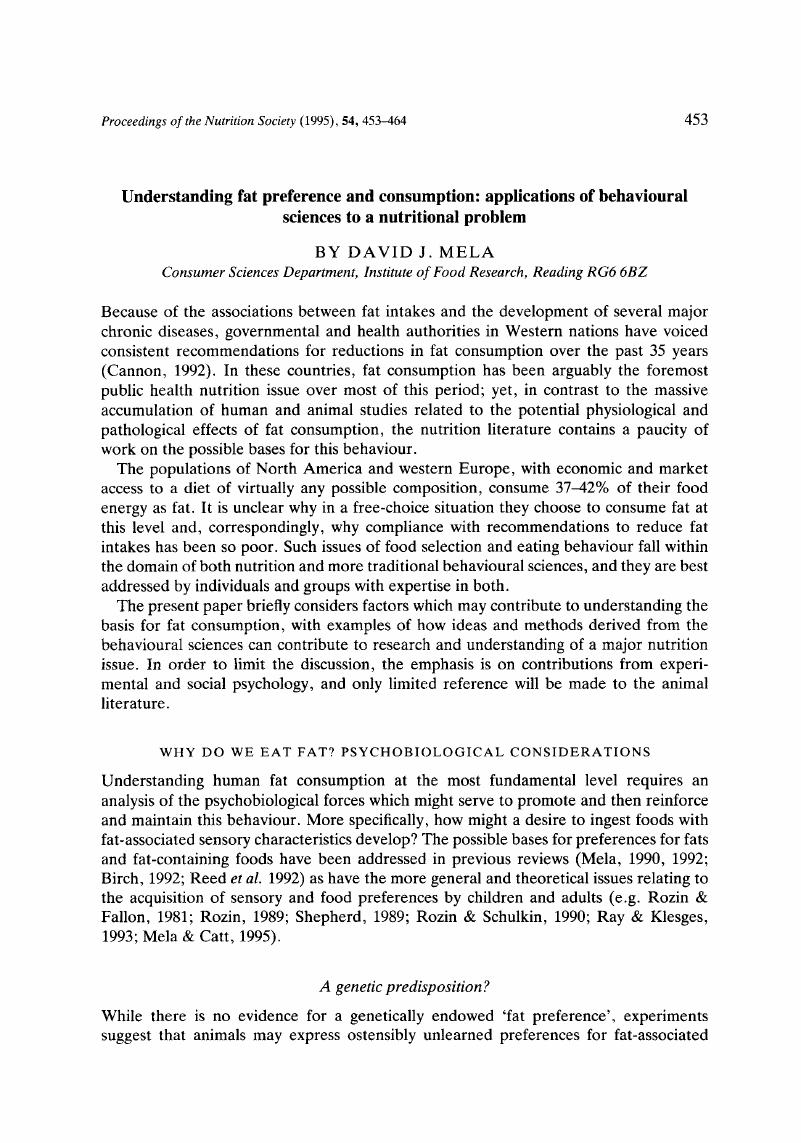Crossref Citations
This article has been cited by the following publications. This list is generated based on data provided by Crossref.
Mela, David J.
1996.
Implications of fat replacement for nutrition and food intake.
Lipid / Fett,
Vol. 98,
Issue. 2,
p.
50.
Mela, David J.
1996.
Eating behaviour, food preferences and dietary intake in relation to obesity and body-weight status.
Proceedings of the Nutrition Society,
Vol. 55,
Issue. 3,
p.
803.
Southgate, D. A. T.
1997.
Production and Processing of Healthy Meat, Poultry and Fish Products.
p.
1.
Mela, David J
1997.
Fetal origins of food preferences?.
Nutrition Bulletin,
Vol. 22,
Issue. 3,
p.
159.
Drewnowski, A.
1997.
TASTE PREFERENCES AND FOOD INTAKE.
Annual Review of Nutrition,
Vol. 17,
Issue. 1,
p.
237.
Prentice, AM
1998.
Manipulation of dietary fat and energy density and subsequent effects on substrate flux and food intake.
The American Journal of Clinical Nutrition,
Vol. 67,
Issue. 3,
p.
535S.
Mela, David J.
1999.
Food choice and intake: the human factor.
Proceedings of the Nutrition Society,
Vol. 58,
Issue. 3,
p.
513.
Ruxton, Carrie
1999.
Why is so much good dietary advice being ignored?.
Nutrition Bulletin,
Vol. 24,
Issue. 2,
p.
117.
Davidson, Isobel H.
Richardson, Rosemary
Sutherland, Donald
and
Garden, James O.
1999.
Macronutrient Preference, Dietary Intake, and Substrate Oxidation Among Stable Cirrhotic Patients.
Hepatology,
Vol. 29,
Issue. 5,
p.
1380.
Gurr, Michael I.
2000.
Handbook of Olive Oil.
p.
521.
Mela, David J
2001.
Why do we like what we like?.
Journal of the Science of Food and Agriculture,
Vol. 81,
Issue. 1,
p.
10.
Harper, Stephanie
and
Rutishauser, Ingrid HE
2001.
What do users of reduced-fat dairy products know about the fat in their diets?.
Public Health Nutrition,
Vol. 4,
Issue. 2,
p.
227.
Takeda, Masami
Imaizumi, Masahiro
Sawano, Shoko
Manabe, Yasuko
and
Fushiki, Tohru
2001.
Long-term optional ingestion of corn oil induces excessive caloric intake and obesity in mice.
Nutrition,
Vol. 17,
Issue. 2,
p.
117.
Shepherd, Richard
2001.
Food, People and Society.
p.
117.
Miettinen, S.‐M.
Piironen, V.
Tuorila, H.
and
Hyvönen, L.
2002.
Electronic and Human Nose in the Detection of Aroma Differences Between Strawberry Ice Cream of Varying Fat Content.
Journal of Food Science,
Vol. 67,
Issue. 1,
p.
425.
Flight, Ingrid
Leppard, Phillip
and
Cox, David N
2003.
Food neophobia and associations with cultural diversity and socio-economic status amongst rural and urban Australian adolescents.
Appetite,
Vol. 41,
Issue. 1,
p.
51.
KIMURA, Fumiko
OKADA, Risa
ENDO, Yasushi
and
FUJIMOTO, Kenshiro
2003.
Bottle-choice Tests in Sprague-Dawley Rats Using Liquid Diets That Differ in Oil and Sucrose Contents.
Bioscience, Biotechnology, and Biochemistry,
Vol. 67,
Issue. 8,
p.
1683.
Kimura, F.
Iida, A.
Endo, Y.
and
Fujimoto, K.
2004.
Bottle choice tests for oxidized oil in rats.
Physiology & Behavior,
Vol. 82,
Issue. 5,
p.
877.
Stubbs, James
and
Whybrow, Stephen
2004.
Beverages in Nutrition and Health.
p.
261.
Brantly, Cynthia A.
Hunt, Alice E.
Gerald, Bonnie
and
Ryan, Cass
2005.
Consumption of High Fat Foods Influences Taste Preferences.
Journal of Nutrition in Recipe & Menu Development,
Vol. 3,
Issue. 3-4,
p.
9.


